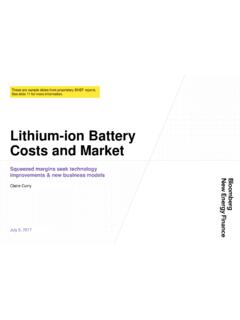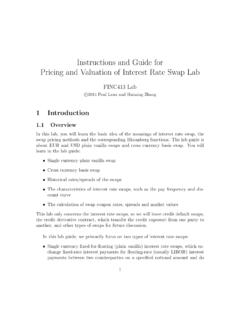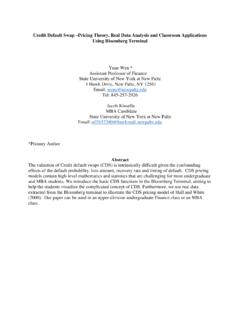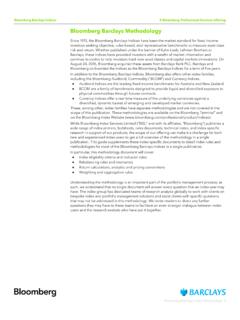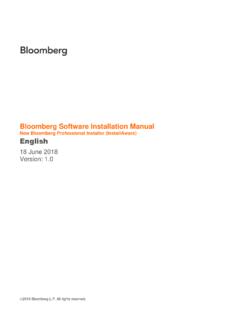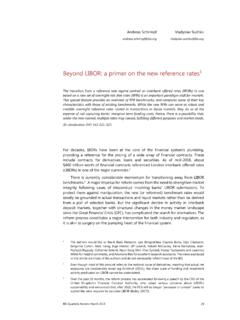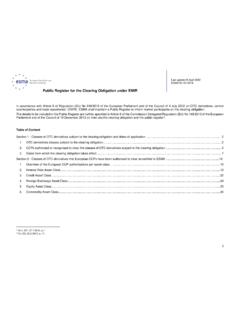Transcription of IBOR Fallback Rate Adjustments Rule Book
1 IBOR Fallback Rate Adjustments Rule Book BISL IBOR Fallback RATE Adjustments RULE BOOK Background Inter-bank Offered Rates ( IBORs ), a series of interest rate benchmarks, are undergoing a period of change as regulators and industry groups have recommended that firms transition away from the London Inter-bank Offered Rate ( LIBOR ) and other IBORs and prepare to replace them with alternative, overnight Risk Free Rates ( RFRs ). These RFRs, including SOFR (USD), STR (EUR) and SONIA (GBP), are typically administered and published by major central banks worldwide. Transitioning to the RFRs will be a demanding and complex process for the industry as RFRs are structurally different from IBORs.
2 They are overnight rates and exhibit different liquidity characteristics and supply/demand issues than IBORs. To address the risk that one or more IBORs are discontinued while market participants continue to have exposure to that rate, counterparties are encouraged to agree to contractual Fallback provisions that would provide for adjusted versions of the RFRs as replacement rates. Due to the fundamental differences in the nature of IBORs and the RFRs, key Adjustments are necessary if RFR fallbacks are to take effect in contracts that were originally negotiated to reference the IBORs. The International Swaps and Derivatives Association, Inc. ( ISDA ) ran public consultations ( ISDA Consultations ) to finalize the adjustment methodologies for derivatives contracts and subsequently issued a tender invitation for a vendor to perform and distribute these necessary Adjustments .
3 More information about the ISDA Consultations can be found here. Bloomberg Index Services Limited ( BISL and, collectively with its affiliates, Bloomberg ) was selected as the vendor to calculate and distribute these RFR Adjustments (each a Rate Adjustment and, collectively, the Rate Adjustments ), including the Adjusted Reference Rate, the Spread Adjustment and the resulting Fallback Rate (as such terms are defined below). This rule book ( Rule Book ) sets out the formulae, definitions, rules and conventions that BISL will implement to calculate the Rate Adjustments in line with the ISDA Consultations referenced above. Without limiting the detail set forth in the formulae, definitions, rules and conventions outlined below, the key Adjustments that the ISDA Consultations arrived at and which this Rule Book seeks to implement are the following: (i) to account for the fact that IBORs have a term structure ( , 1-month, 2-month, etc.)
4 Whereas RFRs are overnight rates, the RFRs will be compounded in arrears over a period similar to the applicable IBOR tenor ( , 30 days for 1-month, 60 days for 2-month, etc.). These compounded RFRs are each generally referred to as the Adjusted Reference Rate ; (ii) to account for the (nearly) risk-free nature of the RFRs v. the liquidity characteristics and supply/demand factors affecting IBORs, a spread adjustment will be calculated for each RFR/IBOR pair (per tenor) using a five year historical median calculation. These calculations are each generally referred to as the Spread Adjustment ; and (iii) adding (i) and (ii) together on a per RFR, per tenor basis for the resulting Fallback Rate . BISL is authorised and regulated by the Financial Conduct Authority. However, users should note that the IBOR transition is to RFRs produced by central banks.
5 The adjustment calculations described in this Rule Book aim to facilitate this transition and the adoption of these RFRs but the Rate Adjustments are not themselves separate benchmarks for purposes of the EU benchmark regulation (or similar applicable frameworks) ( BMR ) . Users should be aware that prior to the Spread Adjustment becoming fixed upon a Spread Adjustment Fixing Date (as defined and determined below), neither the Spread Adjustment nor the Fallback Rate should be used as a primary reference rate within a financial instrument or financial contract (or other use as defined in the BMR) other than as a contractual Fallback . Use of Bloomberg s calculations to the contrary is expressly prohibited. Please see the Frequently Asked Questions document on for further information.
6 Publication Date: 22nd April 2020 Last Updated: 8th October 2020 THIS DOCUMENT IS PROPRIETARY TO ISDA, BLOOMBERG AND THEIR RESPECTIVE AFFILIATES. YOU ARE REFERRED TO THE IMPORTANT DISCLAIMERS AND DISCLOSURES IN THIS DOCUMENT. Table of Contents Section 1. Introduction Section 2. Overview of the Rate Adjustments Section 3. Definitions Section 4. Rate Adjustment Calculations Section 5. General Rules Section 6. Backtest Assumptions Section 7. Licensing, Trademark and Important Disclaimer Information Appendix A Rate Adjustment Information Section 1. Introduction Unless otherwise specified or defined, all capitalized terms referred to in this Rule Book are defined in Section 3 ( Definitions ).
7 This Rule Book has been made available by the Adjustment Services Vendor and sets out the rules applicable to the Rate Adjustments . This version of the Rule Book is provided as of the date specified on the cover of this Rule Book (the Publication Date ). Upon each update to this Rule Book, the most recent version shall be deemed to supersede the preceding version from the date of such update such that, in the event of any conflict between an earlier version of the Rule Book and the most recent version, the most recent version shall prevail. The Adjustment Services Vendor will use reasonable efforts to provide notice of such updates. The Adjustment Services Vendor shall provide additional information about any such updates upon written request. All determinations and calculations made by the Adjustment Services Vendor will (in the absence of manifest error) be final, conclusive and binding.
8 The information contained in this Rule Book includes the formulae and material rules and risks relating to the Rate Adjustments . This information is subject to change. Section 2. Overview of the Rate Adjustments Determination of the Rate Adjustments The Rate Adjustments are calculated by the Adjustment Services Vendor and are based on the value of each of the relevant Underlying Rates as determined in accordance with Section 4 ( Rate Adjustment Calculations ) for each Rate Record Day. The determination of dates used in the calculation is based on the relevant calendars and exchange schedules available at the time of such determination. On any day where a Rate Adjustment is not calculated, no Rate Adjustment shall be published in respect of such day, subject to the provisions set out below. Certain provisions in this Rule Book are expressed in both formulaic and descriptive terms.
9 In the event of conflict between a descriptive term and a formula, the formula shall govern. Determination of the value of each Underlying Rate The Rate Adjustments have been established and designed only for the purpose of seeking to achieve the objectives stated in the Background Section. They have not been designed to reflect the performance of the wider financial markets. The Rate Adjustment shall be a function of the value of the relevant Underlying Rates. In the absence of a Market Disruption Event or Fallback Adjustment Event, the Rate Adjustment shall be calculated in accordance with the formulae (including in circumstances where the market for an Underlying Rate is illiquid or fragmented). This Section 2 ( Overview of the Rate Adjustments ) only provides a summary of the Rate Adjustments and is subject to, and qualified by, the remainder of this Rule Book.
10 Section 3. Definitions STR , or EuroSTR , means the euro short-term rate provided by the European Central Bank (ECB), as administrator of the benchmark, (or any successor administrator); Accrual End Date means, with respect to an IBOR, its Reference Rate, Tenor and a Rate Record Day, (i) if such Tenor is Overnight or Spot Next , the Following Convention Date with respect to such Reference Rate and the Calendar Day immediately succeeding the Accrual Start Date; or (ii) if such Tenor is 1 Week or 2 Weeks , the Following Convention Date with respect to such Reference Rate and the Calendar Day that is 7 (seven) or 14 (fourteen) Calendar Days immediately succeeding the Accrual Start Date, respectively; or (iii) if such Tenor is 1 Month , 2 Months , 3 Months , 4 Months , 5 Months , 6 Months or 12 Months , the Modified Following Convention Date with respect to such Reference Rate and the Calendar Day that is 1 (one), 2 (two), 3 (three), 4 (four), 5 (five), 6 (six) or 12 (twelve) months immediately succeeding the Accrual Start Date, respectively.

